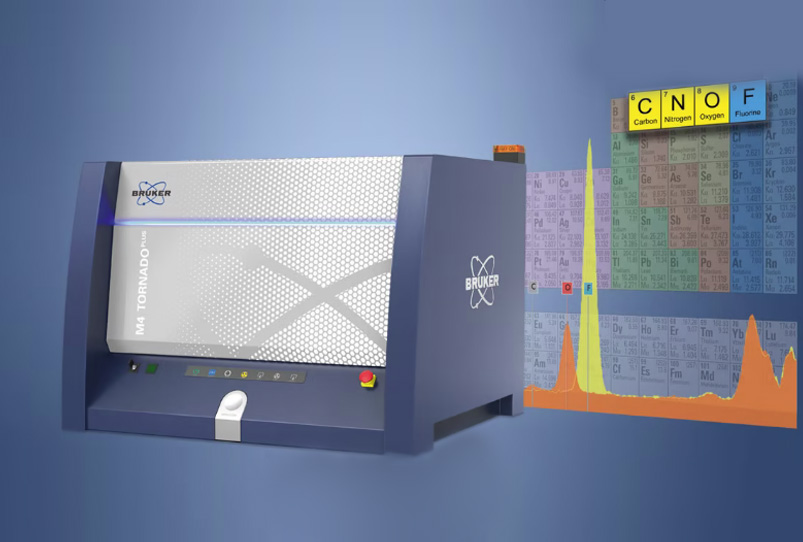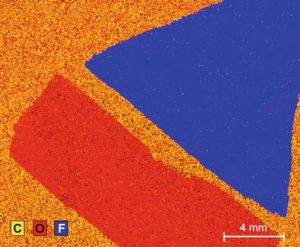Analyse elements from carbon to americium


The Bruker M4 TORNADOPLUS is the world’s first micro-XRF elemental analysis system for light elements down to carbon.
Analyse elements from carbon to americium
Twice the throughput
For samples with topography
Optional Features:
Conventional micro-XRF spectrometers detect elements from sodium upwards. The M4 TORNADOPLUS extends this range to include elements with atomic numbers Z<11, such as fluorine, oxygen, nitrogen and carbon.
There’s no compromise to the performance or sensitivity in the higher energy ranges.
Using two large-area silicon drift detectors with super light element window and a specifically optimized Rh X-ray tube, the M4 TORNADOPLUS is the first Micro-XRF spectrometer ever to enable the analysis of light elements.
This opens up new applications and possibilities for micro-XRF, including:
There are certain materials that standard micro-XRF systems can’t distinguish between. One such example is fluorite (CaF2) and calcite (CaCO3). They both have calcium as a main component, and what differentiates them is the presence of light elements fluorine and oxygen/carbon. Conventional micro-XRF systems would detect only the calcium, because they can’t detect elements with Z < 11 (sodium).
The new M4 TORNADOPLUS is capable of detecting super light elements with its dual large area detectors and light element X-ray tube. This enables the two minerals to be identified easily, clearly highlighting the fluorine, oxygen and carbon.

Light element detection enables clear differentiation between materials such as fluorite and calcite, which were previously indistinguishable with micro-XRF.
Previous dual detector versions of the M4 TORNADO deliver higher throughput than many micro-XRF systems, with an output count rate of up to 260 kcps, compared to the average 90-100 kcps.
This rate has now been increased even further, processing up to 1,200 kcps for an output count rate of up to 550 kcps. This gives you unprecedented acquisition speed , for greater productivity than ever before.
In cases where high X-ray fluorescence intensities are not possible due to the sample type, the pulse throughput is superior due to the low pulse processor dead time. This means that you benefit in every situation, compared to alternative systems:
It’s quick and easy to attach and exchange samples with a quick-change stage and removable stage plate. These are also more secure for reanalysis if necessary. Save time with specimen exchange and setting up measurements, knowing that samples will always be at the same height and position.
Special carriers are also available for drill cores and thin sections.
Samples aren’t always completely flat, and samples with topography can pose a challenge in micro-XRF. Standard systems with high resolution X-ray optics (7 µm) need a small working distance around 2 µm, to achieve a depth of field of less than 1 mm.
The M4 TORNADOPLUS has a software-controlled Aperture Management System (AMS), which gives you a working distance of around 9 mm and a depth of field up to ~5 mm. This maintains a high spatial resolution and keeps sample features in focus, even if the surface height varies by several millimeters.
This opens up micro-XRF to samples with strong topography, which may not have achieved good results before, in fields such as:
An optional second fine focus X-ray tube is available, with a software-controlled 4-position collimator changer. This expands the flexibility of the spot size from 500 µm to 4.5 mm.
Easily switch between a smaller collimated spot with lower intensity, and a larger high intensity spot similar to XRF.
This gives you greater flexibility when studying larger structures and high-energy X-ray lines.
Some samples are pressure-sensitive or at risk of drying out. This causes issues for measurements under a vacuum. Working in ambient air is possible, but X-ray fluorescence from light elements below Ca can be strongly attenuated or even completely absorbed.
For light and super light elements down to carbon and vacuum-sensitive samples, an optional, computer-controlled He-purge system is available that extends the analysis range under atmospheric pressure. There are two purging modes to suit your analytical requirements.
In most cases, local high-flow purging at the measurement position is enough to acquire low energy X-rays for quick single or multi-point analysis.
We offer a range of instruments for elemental and mineral analysis, mapping and imaging in geology and geoscience.
Biomedical, pharmaceuticals, biomaterials and other life science applications.
Instruments for the cement industry
The world's first micro-XRF system that can detect and analyse the complete element range from carbon to americium.
A recording of the launch webinar, introducing the features of the new system.
Contact Us